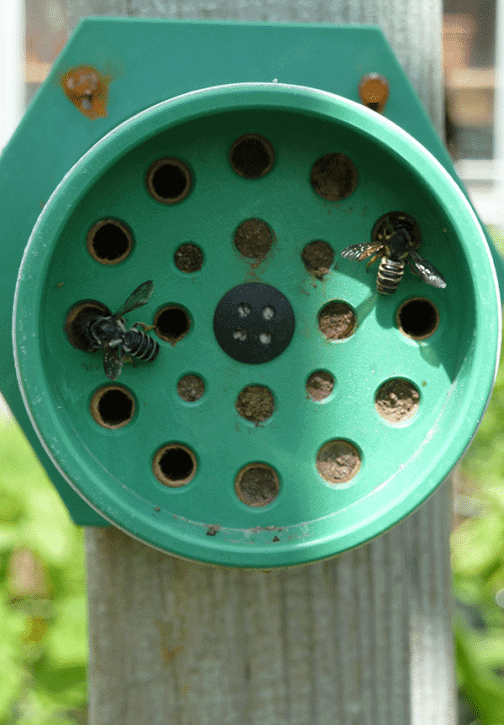
Did you know that there are more than 20,000 species of pollen bees worldwide, and that 3,500 call North America home? Though this number may seem substantial, there has been a severe reduction in the bee population, and both the honey bee and the solitary pollen bee have been affected. As 60% of our food requires pollination, this is of concern to us all. With beekeeping being beyond most of us, many gardeners are turning their attention to helping the solitary pollen bee by installing pollen bee nests in their gardens.
These nests offer the pollen bee a safe home, and the gardeners receive excellent pollination activity; each nest can produce 100-150 bees. With the reduction of the bee population, farmers are also using pollen bees, instead of the honey bees, to pollinate their crops.
We asked Robert Weeden, president and owner of Armstrong & Blackbury Horticultural Products, about the pollen bee nests he developed after several years of research.
What’s the best time of the year to install the pollen bee nest?
Solitary pollen bees are active at different times during the growing season so a nest can be installed at any time during spring, summer and early fall. Many bees will start to emerge when the temperature gets to 15o C and when plants, trees and bushes start to flower.
What is the best location in the typical backyard in terms of height, sun, nearby plants or shrubs?
Installing the nest in a south- or east-facing location at a height of between 12 and 50 inches is suggested. The bees are sun worshippers and prefer a location with morning sun to wake them up and midday sun to keep the nest warm. As most solitary pollen bees stay close to their nest, it’s important to ensure a variety of plants are available. Choose plants that offer a succession of blooms throughout the season and plant in clumps rather than scattered throughout the garden. Plants that are native to the growing area will provide food to bees that are native. Your herb garden and vegetable patch also provide great feeding areas for the bees.
Will the nest attract wasps or less desirable insects?
The solitary pollen bee nest will not attract wasps or hornets. It is scientifically designed to attract the harmless pollen bee only. Most hornets, wasps and yellow jackets live in colonies and wouldn’t use the single nest tubes in the pollen bee nest.
How long might it take for pollen bees to discover the nests?
It may take a few weeks for the bees to find and deem the nest safe to use. Placing water in the garden may encourage them to take up residence; bees use water and soil to build their nest. If mulch is used on the flower beds, ensure that some areas are left uncovered to enable the bees to use soil to seal their cells inside the tubes.
How much maintenance is required to see the nest in use from one year to the next?
The nest can be left in the garden all year; it’s insulated and weather resistant. Once the tubes are filled and closed by the bee, it will take up to 12 months for the new bees to emerge. The nest can be cleaned after the bees have emerged and the tubes are empty.

If there is more than one nest, how far apart should they be?
Most pollen bees are solitary bees, with one female per nest and no queen or worker bees. These females can be very gregarious, preferring to make their nest side-by-side in the same area, much like urban apartment dwellers. Solitary pollen bee nests can be placed quite close to each other in the garden or throughout as space allows.










What hardiness zone can these bees survive in?
Is full-sun exposure all day too much? I am assuming that shelter means not being overly exposed to wind and such?
Thanks
Placing the nest in full sun should be OK as the nest is insulated. However, we do recommend some shade if possible, with morning sun being prefrred by the bees. Hope that helps.
Regards,
Pollenbeenest.com
We have kept mason bee nest boxes for years but it worries me a little that you suggest just leaving them until they hatch and then cleaning the nest boxes. Mites have become quite a problem in our area (Salt Spring Island) and so my husband sterilizes sand (on the woodstove) and shakes the cocoons with the sand in a glass bottle until the mites are removed and then stores the clean cocoons in a hatching box for spring hatching.An alternate method is using a weak bleach solution to clean the cocoons but the clean sand seems less intrusive. He then cleans all the boxes with soap and water and dries them to store for the upcoming spring use.
I have a bee nest in my garden but unfortunately it hasn’t been inhabited yet; I think I may have to change the location according to the directions listed here. I have 2 large birdbaths in my garden and one of them has been visited non-stop on a daily basis by bees. I’ll see as many as 12 at one time, perched on the perimeter of the bath presumably taking water back to their nest/hive. I usually change the water daily (it’s used regularly by many birds) and I have to be careful with so many bees though so far no stings! They seem to understand that I’m providing them with clean water. I’m finding these visitations very interesting and the first time I’ve ever seen this in all my years of gardening.
Wonderful idea. Where can I buy one ?
Hi Barb, Here’s the link (it’s in the story but perhaps not obvious): http://www.pollenbeenest.com/PollenBeeNest_Purchase.html